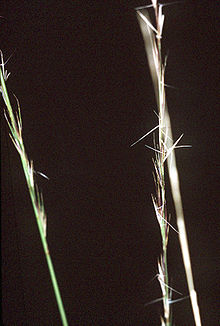|
Aristida
 Aristida is a very nearly cosmopolitan genus of plants in the grass family.[4][5] Aristida is distinguished by having three awns (bristles) on each lemma of each floret.[6] The genus includes about 300 species found worldwide, often in arid warm regions. This genus is among those colloquially called three-awns wiregrasses, speargrasses and needlegrasses.[7][8][9] The name Aristida is derived from the Latin "arista", meaning "awn".[10] They are characteristic of semiarid grassland. The Wiregrass Region of North America is named for A. stricta. Other locales where this genus is an important component of the ecosystem include the Carolina Bays, the sandhills of the Carolinas, and elsewhere, Mulga scrub in Australia, and the xeric grasslands around Lake Turkana in Africa. Local increases in the abundance of wiregrasses is a good indicator of overgrazing, as livestock avoid them. DescriptionAristida stems are ascending to erect, with both basal and cauline leaves. The leaves may be flat or inrolled, and the basal leaves may be tufted. The inflorescences may be either panicle-like or raceme-like, with spiky branches. The glumes of a spikelet are narrow lanceolate, usually without any awns, while the lemmas are hard, three-veined, and have the three awns near the tip. The awns may be quite long; in A. purpurea var. longiseta they may be up to 10 cm. SpeciesSelected species include:
See also
References
|
||||||||||||||||||||||||||||||||||||||||
Portal di Ensiklopedia Dunia
